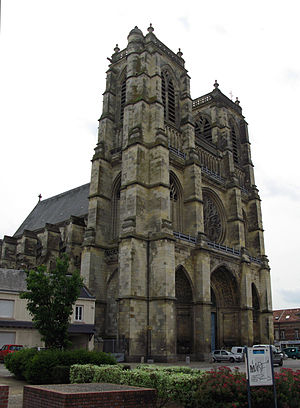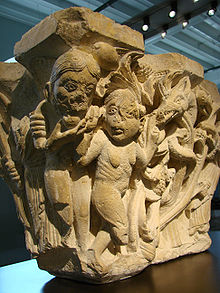- Corbie Abbey
-
Corbie Abbey is a former Benedictine monastery in Corbie, Picardy, France, dedicated to Saint Peter.
Contents
Foundation
It was founded in about 659/661 under Merovingian royal patronage by Balthild, widow of Clovis II, and her son Clotaire III. The first monks came from Luxeuil Abbey, which had been founded by Saint Columbanus in 590, and the Irish respect for classical learning fostered there was carried forward at Corbie. The rule of the founders was based on the Benedictine rule, as Columbanus had modified it.
Besides gifts of estates to support the abbey, many exemptions were granted to the abbots, to free them from interference from local bishops: the exemptions were confirmed in 855 by Pope Benedict III. The abbots ranked as counts and had the privilege of a mint.
Carolingian period
Corbie continued its intimate links with the royal house of the Carolingians. In 774 Desiderius, last King of the Lombards, was exiled here after his defeat by Charlemagne. From 850 to 854 Charles, the future Archbishop of Mainz, was confined here. Members of the Carolingian house sometimes served as abbots; a notable abbot was Saint Adalard, one of Charlemagne's cousins.
In the ninth century Corbie was larger than St. Martin's Abbey at Tours, or Saint Denis at Paris. Corvey Abbey in Saxony was founded from Corbie in about 820, and was named after it.
Above all, Corbie was renowned for its library, which was assembled from as far as Italy, and for its scriptorium. In addition to its patristic writings, it is recognized as an important center for the transmission of the works of Antiquity to the Middle Ages. An inventory (of perhaps the 11th century) lists the church history of Hegesippus, now lost, among other extraordinary treasures. In the scriptorium at Corbie the clear and legible hand known as Carolingian minuscule was developed, in about 780 [2], as well as a distinctive style of illumination.
Three of Corbie's ninth-century scholars were Ratramnus (died c. 868), Radbertus Paschasius (died 865) and the shadowy figure of Hadoard. Jean Mabillon, the father of paleography, had been a monk at Corbie.
Among students of Tertullian, the library is of interest as it contained a number of unique copies of Tertullian's works, the so-called corpus Corbiense and included some of his unorthodox Montanist treatises, as well as two works by Novatian issued pseudepigraphically under Tertullian's name. The origin of this group of non-orthodox texts has not satisfactorily been identified.[1]
Geometry
Among students of medieval architecture and engineering, such as are preserved in the notebooks of Villard de Honnecourt, Corbie is of interest as the center of renewed interest in geometry and surveying techniques, both theoretical and practical, as they had been transmitted from Euclid through the Geometria of Boethius and works by Cassiodorus (Zenner).
Modern times
In 1638, 400 manuscripts were transferred to the library of the monastery of St. Germain des Prés in Paris. In the French Revolution, the library was closed and the last of the monks dispersed: 300 manuscripts still at Corbie were moved to Amiens, 15 km to the west. Those at St-Germain des Prés were loosed on the market, and many rare manuscripts were obtained by a Russian diplomat, Petrus Dubrowsky, and sent to St. Petersburg. Other Corbie manuscripts are at the Bibliothèque Nationale. Over two hundred manuscripts from the great library at Corbie are known to survive.
Burials
- Radbertus Paschasius
- Saint Martin of Arades (died 726)
See also
Notes
Further reading
- Ganz, David (1990). Corbie in the Carolingian Renaissance. Sigmaringen: Thorbecke. ISBN 3-7995-7320-8.
- Mérindol, Christian de; Garrigou, Gilberte, eds (1991) (in French). Les manuscrits de l’Abbaye de Corbie: exposition du 10 au 16 novembre 1991. Amis du Vieux Corbie.
External links
- Catholic Encyclopedia: Abbey of Corbie
- Mmss of Tertullian at Corbie
- An 8th–9th century Ms of Tertullian Apologeticum from Corbie
- Les grandes heures de Corbie: timeline (in French and English)
- Merovingian minuscule, 7th-8th centuries, as used at Corbie
- Philip Schaff, History of the Christian church iv: (Paschasius Radbert)
- Marie-Thérèse Zenner, "Villard de Honnecourt and Euclidian geometry"
Categories:- Benedictine monasteries in France
- Carolingian architecture
- Libraries in France
- Christian monasteries established in the 7th century
- Franks
- Corbie Abbey
Wikimedia Foundation. 2010.


